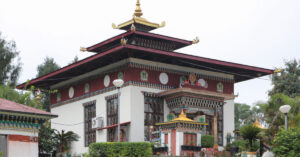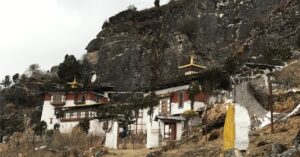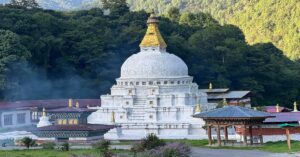Yongla Goenpa, also known as Yongla Riwo Pelbar Dargeychholing Goenpa, is one of the oldest and most revered Goenpas in eastern Bhutan, founded by Kheydrup Jigme Kuendrel in the 18th century. It is located on a mountaintop that resembles a Phurba or ritual dagger in Pemagatshel Dzongkhag. Dorji Jamtsho, the second Yongla Lam, built Yongla Gonpa to honor Kheydrup Jigme Kuendel, who founded and meditated on this holy site in 1736.
This sacred site was blessed by visits of many great Buddhist luminaries like His Holiness Dudjom Rinpoche Jigdrel Yeshey Dorji, Terton Pema Lingpa, Lam Pema Longdrel, Dungsey Rinpoche Thinley Norbu, Nyulshu Khenpo, Lhalung Thuksey Rinpoche, and many others in the past.
It is said that Bhutan’s sovereignty is guarded by Yongla Goemba in Pemagatshel from the South and Rigsum Goenpa in Trashiyangtse from the North.
How to Reach Yongla Goenpa
Are you wondering how to get to Yongla Gompa? Yongla Gonpa is located under Zobel Gewog of Pemagatshel. Drive from Samdrup Jongkhar toward Trashigang till you reach the Tshelingore junction, where the road diverts to Pemagatshel. From Tshelingkhor, the Goenpa is a half-hour journey. If you are traveling from Pemagatshel town, the monastery is 15 kilometers away.
Sacred Relics to see at Yongla Goenpa
- Phurpai Drupchhen;
- Local deities Dhoenyen Zangpo and Kaley Yongba;
- Thousands of miniature Dorji Drolo Statues;
- Harsum Maagdhu;
- Dorji Drolo;
- Phurba Lhatshog;
- Zhabdrung;
- Padmasambhava;
- Chenrigze.
Also Read: Guru Rinpoche in Bhutan: His Visits to Bhutan and Sacred Sites
Historical Significance of Yongla Goenpa
The historical significance of Yongla Goenpa was not recorded until Lam Sonam Zangpo, the 11th abbot of Yongla Goenpa, asked Lopon Dozong to document its history. According to the history of Yongla Goenpa, the Goenpa was founded by Khedrup Jigme Kendrel from Darlukha in Thimphu in the 18th century, as per the prophecy of his master Rigzin Jigme Lingpa.
Legend has it that, in a vision, the great Treasure Discoverer Rigzin Jigme Lingpa, a disciple of Kunkhen Longchen Ramjam, saw an abode of holy Vajra similar to places like Tsarita, Singye Dzong, etc.
Therefore, Rigzin Jigme Lingpa instructed Kheydrup Jigme Kuendrel to go to Bhutan and find a place that resembled a ritual dagger (Vajra). Following the prophecy, he traveled from Tibet and arrived in Bumthang. He went up to the Wangthangla top in Ura and wondered if that particular place was the site prophesied by Terton Rigzin Jigme Lingpa. But the goddess Dechhen Gyalmo appeared and pointed towards Yongla, the place of prophecy, and instructed him to go there.
When he arrived at Yongla, he entered meditation and subsequently taught the teachings of Jigme Lingpa to the local people. Some sources claim that Jigme Kundrol arranged the texts of the Longchen Nyingtik teachings here.
Another historical significance of Yongla Gonpa is its use as a military operation base by the Trongsa Penlop Jigme Namgyel during the Duar War to launch raids on British troops in 1864-1865.
How did it get named Yongla?
When Kheydrup Jigme Kundrel arrived at the present site of Yongla, Kundrel asked the goddess Dechhen Gyalmo if the place was as prophesied by Rigzin Jigme Lingpa. The goddess replied, “Yong Yong,” which translates to “Yes, Yes.” Since then, the sacred site has come to be known as Yongla.
Description of Yongla Goenpa
Yongla Riwo Pelbar Dargeychholing Goenpa, also known as Pelri Gonpa, sits majestically on a dagger-shaped mountaintop of Pemagatshel.
Yongla Gonpa was built in 1736 by the second Yongla Lam, Dorji Jamtsho, exactly a year after the death of Khedrup Jigme Kuendel, who founded, meditated, and blessed this sacred place following the instructions of his master Rigzin Jigme Lingpa. In addition, Lam Dorji Jamtsho also established and consecrated the nunnery of Jashar Anim Goenpa in Pemagatshel, located at the foot of Yongla Goemba.
During the appointment ceremony of Chogyal Minjur Tenpa as the Trongsa Penlop, three Lams (Choedrak Lam, Rigsum Lam, and Yongla Lam) were also appointed from Trongsa Rabdey. Since then, it has become customary to appoint these Lams from Trongsa Rabdey.
According to records, Lam Sonam Zangpo, the 11th Abbot of Yongla Goenpa, expanded the Gompa in 1968. He painted the murals inside the walls of Yongla Goenpa and built Kuten and Chorten. In 1969, he reinstated Annual Drubchen, introduced Masked Dances, and enrolled 25 monks.
Over time, the monastery has seen 16 successive lams lead as the abbot of Gonpa, each of whom has added to its spiritual heritage.
Yongla Monastery
The Yongla Goenpa Lhakhang was built in the late 1980s. The ground floor houses the local deities Dhoenyen Zangpo and Kaley Yongba far inside the altar. The shrine, known as Droley Lhakhang, is home to thousands of miniature Dorji Drolo Statues along with other larger Harsum Maagdhu, Dorji Drolo, and Phurba Lhatshog. The top floor honors Zhabdrung Rinpoche, Guru Rinpoche, and Chenrezig.
Yongla Goenpa was severely damaged when the 6.1-magnitude earthquake hit the nation on 21 September 2009. Following this disaster, His Majesty the King visited the Goenpa and commanded it to be restored. The reconstruction of the Yongla Gonpa started in 2011 and was restored to its former glory in 2019.
Yongla Phurbai Drupchen Festival
Yongla Phurpai Drubchen was initiated by Kheydrup Jigme Kuendrol as a powerful spiritual ritual to strengthen Bhutan’s sovereignty against external threats from the South.
According to legend, border disputes with British India occurred during the time of the 17th Druk Desi Kuenga Rinchen. At the Druk Desi’s order, Norbu Pelkar, the first Dungsam Jadrung and a patron of Jigme Kuendrel, left for Calcutta and resolved the disputes with a treaty. Due to this positive outcome, Norbu Pelkar requested Kheydrup Jigme Kuendrel to initiate the Yongla Mendrub Drubchen. It is said that the wars in the south ended only when Lam Jigme Kuendrel conducted Drupchhen here.
However, its significance was lost during the reign of successive Lams. The Drubchen was only reinstated in the 1960s by Lam Sonam Zangpo, the 11th abbot of Yongla Goenpa. The significance became popular when His Holiness Dudjom Rinpoche visited in 1970.
In the past, the annual Phurpai Drubchen was conducted on the Descending Day of Lord Buddha, with support from the people’s harvest. But now it is observed in September with support from the government and local communities. The Drupchhen lasts for ten days. On the final day, the devotees also receive blessings from the sacred relics of Phurpa and Phurpai Wang from the Lam Neten of Pema Gatshel Rabdey.
Best Time to Visit Yongla Goenpa
Yongla Goenpa can be accessed throughout the year. However, the best time would be to visit during the Yongla Phurbai Drubchen, which is held annually in September. You can visit the major pilgrimage sites of Pemagatshel with the Bhutan Pilgrimage Package.
Frequently Asked Questions
Who founded Yongla Goenpa?
Although Yongla Goenpa was founded by Yongla Lam Dorji in 1736, the monastery was originally built by Kheydrup Jigme Kundel in the 18th century.
What is the significance of Yongla Goenpa?
Yongla Goenpa is significant because this sacred site was founded by Kheydrup Jigme Kuendrel in the 18th century, according to Rigzin Jigme Lingpa’s prophecy. Yongla Goenpa was also used as an operational base to launch raids upon British troops during the Duar War.
Enjoyed reading this blog?




